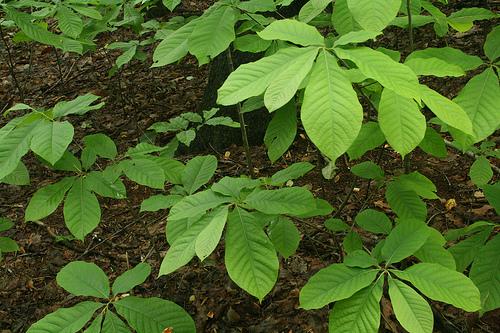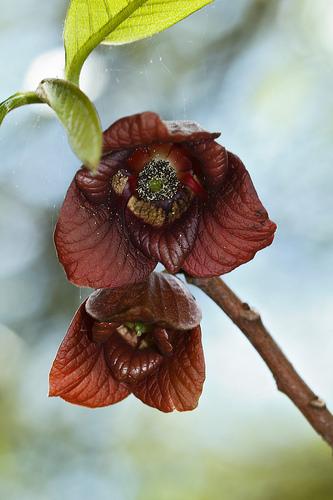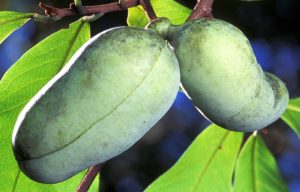Name That Tree
By Gretchen Spencer, Fairfax Master Gardener
 Pawpaw (Asimina triloba) is the correct answer! This small, deciduous tree is native to the eastern and central United States, and its range extends from northern Florida to southern Ontario and west to eastern Nebraska. It is the only North American member of a tropical family of trees, Annonaceae, or the custard-apple family.
Pawpaw (Asimina triloba) is the correct answer! This small, deciduous tree is native to the eastern and central United States, and its range extends from northern Florida to southern Ontario and west to eastern Nebraska. It is the only North American member of a tropical family of trees, Annonaceae, or the custard-apple family.
It typically grows to about 20 to 25 feet tall. An understory tree, it thrives best in moist, fertile soil that is slightly acid. As a seedling or very young tree, it needs shade for the first two years. Young trees are sensitive to bright sunlight. While it can grow in shade, it will produce the most fruit with full sun. Many new cultivars have been developed that tolerate a wider range of soil conditions and produce larger fruit.
 Although small in stature, its droopy oblong leaves are large, 6 to 12 inches long, and turn yellow in the fall. The maroon-colored flowers appear in early spring and hang upside-down. The triloba in its Latin name refers to the flower’s three petals. Each flower has several ovaries that develop into a fruit cluster from September to October. The flower has a rank odor and is pollinated by flies or beetles, not bees.
Although small in stature, its droopy oblong leaves are large, 6 to 12 inches long, and turn yellow in the fall. The maroon-colored flowers appear in early spring and hang upside-down. The triloba in its Latin name refers to the flower’s three petals. Each flower has several ovaries that develop into a fruit cluster from September to October. The flower has a rank odor and is pollinated by flies or beetles, not bees.
Its most distinguishing attribute is its fruit, reputed to be the largest native edible fruit in America. It produces clusters of large, mango-like “berries” whose taste has been compared to that of a banana, a mango, a pineapple or a combination of the three. I’ve never tried one, so I can’t confirm which fruit taste is most prominent. However, its flavor is described as delightful and unique. The yellowish-green fruit ripens to brownish black; its flesh is bright yellow to yellowish brown. The fruit is nutritious and contains high amounts of vitamins A and C as well as potassium.
 The pawpaw has few to no pests and thus does not require regular applications of pesticides. Deer, too, avoid its twigs and leaves. Thus, the tree and its delectable fruit have become more popular in recent years, especially among organic fruit growers. The University of Kentucky has a full-time pawpaw research program. In 2016, it released a new variety that has high yield, round, medium-sized fruit that can be packed easily. Their website also has recipes for pawpaw ice cream, pies, custards cakes, cookies and more. While the fruit bruises easily, it can be pureed and frozen for later use.
The pawpaw has few to no pests and thus does not require regular applications of pesticides. Deer, too, avoid its twigs and leaves. Thus, the tree and its delectable fruit have become more popular in recent years, especially among organic fruit growers. The University of Kentucky has a full-time pawpaw research program. In 2016, it released a new variety that has high yield, round, medium-sized fruit that can be packed easily. Their website also has recipes for pawpaw ice cream, pies, custards cakes, cookies and more. While the fruit bruises easily, it can be pureed and frozen for later use.
I learned a few other interesting facts about the pawpaw tree. Its leaves are the larval food for our native zebra swallowtail, one of our most beautiful swallowtails with long hindwings. It is also called the pawpaw butterfly.
The pawpaw has a long taproot that goes completely dormant in winter. It is difficult to transplant young plants, so it is better to purchase bare-root or young container grown plants so that the taproot is protected. However, in its native habitat, the pawpaw often forms thickets from root sprouts. This must be the derivation of the traditional folk song, “Picking up pawpaws put ‘em in a basket, way down yonder in the pawpaw patch,” a song I remember well from my childhood.
Now I know all about pawpaws! I am eager to try its unique fruit. Next fall, I will have to scour the farmers markets or research grocery stores where I might find some. I am eager to experience this native fruit, and I hope you are, too.
References
Pawpaw, Virginia Tech Dendrology
Pawpaw, Asimina triloba, Virginia Polytechnic Institute and State University
Growing Pawpaws, Purdue University Cooperative Extension Service, HO-220-W
Pawpaw: The Midwest Banana?, Purdue Agriculture,
KSU Pawpaw Program, Kentucky State University
Kentucky State University Announces Release of New North American Pawpaw Variety, KSU-Benson
Journey with Nature, Pawpaw Trees, The Nature Conservancy
Native PawPaw Tree, Caldwell County Center, NC Cooperative Extension
Asimina triloba, NC Extension, NC State University